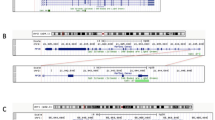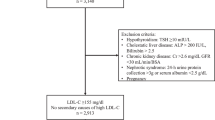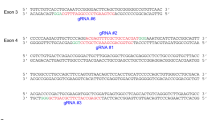Abstract
Familial hypercholesterolemia (FH) is a genetic disorder mainly caused by defects in the low-density lipoprotein receptor (LDLR) gene, although it can also be due to alterations in the gene encoding apolipoprotein B (familial defective apoB or FDB) or in other unidentified genes. In Morocco, the molecular basis of FH is unknown. To obtain information on this issue, 27 patients with FH from eight unrelated families were analyzed by screening the LDLR (PCR-SSCP and Southern blot) and apoB genes (PCR and restriction enzyme digestion analysis). None of the patients carried either the R3500Q or the R3531C mutation in the apoB gene. By contrast, seven mutations in the LDLR gene were identified, including five missense mutations on exons 4, 6, 8, and 14 (C113R, G266C, A370T, P664L, C690S) and two large deletions (FH Morocco-1 and FH Morocco-2). The two major rearrangements and the missense mutation G266C are novel mutations and could well be causative of FH in the Moroccan population. This study has yielded preliminary information on the mutation spectrum of the LDLR gene among patients with FH in Morocco.
Similar content being viewed by others
Log in or create a free account to read this content
Gain free access to this article, as well as selected content from this journal and more on nature.com
or
References
Fisher E, Scharnagl H, Hoffmann MM, et al. (1999) Mutations in the apolipoprotein (apo) B-100 receptor-binding region: detection of apo B-100 (Arg3500→Trp) associated with two new haplotype and evidence that apo B-100 (Glu3405→Gln) diminishes receptor-mediated uptake of LDL. Clin Chem 45:1026–1038
Fouchier SW, Defesche JC, Umans-Eckenhausen MA, Kastelein JJ (2001) The molecular basis of hypercholesterolemia in the Netherlands. Hum Genet 109:602–615
Friedewald WT, Levy FI, Fredrickson DS (1972) Estimation of the concentration of the low density lipoprotein cholesterol in plasma without use of the preparative ultracentrifuge. Clin Chem 18:499–509
Gaffney D, Reid JM, Cameron IM, Vass K, Caslake M, Sheperd J, Packard CJ (1995) Independent mutations at codon 3500 of the apolipoprotein B gene are associated with hyperlipidaemia. Arterioscler Thromb Vasc 15:1025–1029
Goldstein JL, Hobbs HH, Brown MS (1995) Familial hypercholesterolemia. In: Scriver CR, Beaudet AL, Sly W, Valle D (eds) The metabolic and molecular bases of inherited disease, 7th edn. McGraw-Hill, New York, pp 1981–2030
Gudnason V, Patel D, Sun X-M, Humphries S, Soutar AK, Knight BL (1995) Effect of the StuI polymorphism in the LDL receptor gene (Ala370 to Thr) on lipid levels in healthy individuals. Clin Genet 47:68–74
Haddad L, Day IN, Hunt S, Williams RR, Humphries SE, Hopkins PN (1999) LDLR, non-APOB kindred. J Lipid Res 40:1113–1122
Heath KE, Gahan M, Whittal RA, Humphries SE (2001) Low-density lipoprotein receptor gene (LDLR) world-wide web site in familial hypercholesterolemia: update, new features and mutation analysis. Atherosclerosis 154:243–246
Hobbs H, Brown MS, Goldstein JL (1992) Molecular genetics of the LDL receptor gene in familial hypercholesterolemia. Hum Mutat 1:4445–4466
Humphries SE, Gudnason V, Whittall R (1997) Single-strand conformation polymorphism analysis with high throughput modifications, and its use in mutation detection in familial hypercholesterolemia. Clin Chem 43:427–435
Hunt SC, Hopkins PN, Bulka K, McDermott MT, Thorne TL, Wardell BB, Bowen BR, Ballinger DG, Skolnick MH, Samuels ME (2000) Genetic localization to chromosome 1p32 of the third locus for familial hypercholesterolemia in Utah kindred. Arterioscler Thromb Vasc Biol 20:1089–1093
Jensen HK, Jensen LG, Hansen PS, Faergeman O, Gregersen N (1996) High sensitivity of the single-strand conformation polymorphism method for detection of sequence variations in the LDL receptor gene validated by DNA sequence. Clin Chem 42:1140–1146
Leren TP, Tonstad S, Gudersen KE, Bakken KS, Rodningen OK, Sundvold H, Ose L, Berg K (1997) Molecular genetics of familial hypercholesterolemia in Norway. J Intern Med 241:185–194
Lestavel S, Fruchart JC (1994) Lipoprotein receptors. Cell Mol Biol 40:461–481
Miller SA, Dykes DD, Polesky HF (1988) A simple salting out procedure for extracting DNA from nucleated cells. Nucleic Acids Res 16:1215
Myant NB (1993) Familial defective apolipoprotein B-100: a review, including some comparisons with familial hypercholesterolemia. Atherosclerosis 104:1–18
Nauck MS, Köster W, Dörfer K, Eckes J, Scharnagl H, Gierens H, Nissen H, Nauck MA, Wieland H, März W (2001) Identification of recurrent and novel mutations in the LDL receptor gene in German patients with familial hypercholesterolemia. Hum Mutat 18:165–166
Norman D, Sun XM, Bourbon M, Knight BL, Naoumova RP, Soutar AK (1999) Characterization of a novel cellular defect in patients with phenotypic homozygous familial hypercholesterolemia. J Clin Invest 104:619–628
Pullinger CR, Hennessy LK, Chatterton JE, Liu W, Love JA, Mendel CM, Frost PH, Malloy MJ, Schumaker VN, Kane JP (1995) FDB: identification of a new mutation that decrease LDL-receptor binding affinity. J Clin Invest 95:1225–1234
Rabès JP, Varret M, Saint-Jore B, Erlich D, Jondeau G, Giraudet P, Junien C, Boileau C (1997) Familial ligand-defective apolipoprotein B-100: simultaneous detection of the Arg3500→Gln and Arg3531→Cys mutations in a French population. Hum Mut 10:160–163
Soria LF, Ludwig EH, Clarke HRG, Vega GL, Grundy SM, McCarty BJ (1989) Association between a specific apo B mutation and familial defective apoB100. Proc Natl Acad Sci U S A 86:587–591
Soutar AK, Knight BL, Patel DD (1989) Identification of a point mutation in growth factor receptor C of the low density lipoprotein-receptor gene in a patient with homozygous familial hypercholesterolemia that affects ligand binding and intracellular movement of receptors. Proc Natl Acad Sci U S A 86:4166–4170
Varret M, Rabès JP, Kotze MJ, Baron H, Cenarro A, Descamps O, Ebhardt M, Nondelijn JC, Kostner GM, Miyake Y, Pocovi M, Shmidt H, Schuster H, Stuhrmann M, Yamamura T, Junien C, Beroud C, Boileau C (1998) LDLR database (second edition): new additions to the database and the software, and results of the first molecular analysis. Nucleic Acids Res 26:248–252
Varret M, Rabès JP, Saint-Jore B, Cenarro A, Marinoni JC, Civeira F, Devillers M, Krempf, Culon M, Thiart R, Kotze MJ, Schmidt H, Buzzi JC, Kostner GM, Bertoleni S, Rosa A, farnier M, Martinez M, Junien C, Boileau C (1999) A third major locus for autosomal dominant hypercholesterolemia maps to 1p34.1–32. Am J Human Gene 64:1378–1387
Weiss N, Binder G, Keller C (1998) Heterozygosity for the missense mutation Ala370→Thr in exon 8 of the low density lipoprotein receptor gene does not cause hypercholesterolemia. Eur J Med Res 3:20–24
Yamamoto T, Davis CG, Brown MS, Schneider WJ, Casey ML, Goldstein JL, Russell DW (1984) The human LDL receptor: a cysteine-rich protein with multiple Alu sequences in its mRNA. Cell 39:27–38
Acknowledgements
We thank the many clinicians who provided the blood samples and clinical data of their FH patients. We also thank Dr. A. Cenarro for critical reading of the manuscript.
Author information
Authors and Affiliations
Corresponding author
Rights and permissions
About this article
Cite this article
El Messal, M., Aït Chihab, K., Chater, R. et al. Familial hypercholesterolemia in Morocco: first report of mutations in the LDL receptor gene. J Hum Genet 48, 199–203 (2003). https://doi.org/10.1007/s10038-003-0010-x
Received:
Accepted:
Published:
Issue date:
DOI: https://doi.org/10.1007/s10038-003-0010-x
Keywords
This article is cited by
-
Common and rare single nucleotide polymorphisms in the LDLR gene are present in a black South African population and associate with low-density lipoprotein cholesterol levels
Journal of Human Genetics (2014)
-
Familial hypercholesterolemia associated with severe hypoalphalipoproteinemia in a Moroccan family
Journal of Genetics (2007)
-
ApoB-100 R3500Q mutation in the Lebanese population: Prevalence and historical review of the literature
Molecular Biology Reports (2007)



